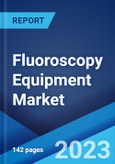The global fluoroscopy equipment market size reached US$ 6.3 Billion in 2023. Looking forward, the publisher expects the market to reach US$ 8.9 Billion by 2032, exhibiting a growth rate (CAGR) of 3.91% during 2023-2032.
Fluoroscopy equipment allows the positioning of the X-ray source assembly. It generally utilizes collimators, computers, X-ray tubes, spectral shaping filters, anti-scatter grids, image receptors, display devices, high-voltage generators, patient-support devices and hardware. It also uses an X-ray image intensifier (XRII) and video camera to produce grayscale inverted images in real-time, thereby evaluating dynamic biological processes and guiding interventions. Consequently, it is used in radiographic imaging of skeletal, digestive, urinary, respiratory, and reproductive body structures. It can be manufactured in a variety of configurations and used in conjunction with other diagnostic procedures.
The amplification and overall efficiency of modern fluoroscopy equipment protect healthcare providers from secondary radiation exposure. It also has advanced 3D capability, which allows minimally invasive (MI) imaging of patients with a low radiation dose. This, along with the escalating need for interventional radiology (IR) on account of the growing prevalence of chronic diseases and a considerable increase in the demand for MI methods, is expanding the application of fluoroscopy equipment in various diagnostic examinations and procedures. Apart from this, mobile C-arm fluoroscopy equipment is gaining traction in surgical suites, and offices and sports medicine for emergency care. Moreover, the key players are introducing advanced features, such as variable frame rate, automatic beam filtration and image post-processing, which is anticipated to drive the market in the coming years.
Fluoroscopy equipment allows the positioning of the X-ray source assembly. It generally utilizes collimators, computers, X-ray tubes, spectral shaping filters, anti-scatter grids, image receptors, display devices, high-voltage generators, patient-support devices and hardware. It also uses an X-ray image intensifier (XRII) and video camera to produce grayscale inverted images in real-time, thereby evaluating dynamic biological processes and guiding interventions. Consequently, it is used in radiographic imaging of skeletal, digestive, urinary, respiratory, and reproductive body structures. It can be manufactured in a variety of configurations and used in conjunction with other diagnostic procedures.
The amplification and overall efficiency of modern fluoroscopy equipment protect healthcare providers from secondary radiation exposure. It also has advanced 3D capability, which allows minimally invasive (MI) imaging of patients with a low radiation dose. This, along with the escalating need for interventional radiology (IR) on account of the growing prevalence of chronic diseases and a considerable increase in the demand for MI methods, is expanding the application of fluoroscopy equipment in various diagnostic examinations and procedures. Apart from this, mobile C-arm fluoroscopy equipment is gaining traction in surgical suites, and offices and sports medicine for emergency care. Moreover, the key players are introducing advanced features, such as variable frame rate, automatic beam filtration and image post-processing, which is anticipated to drive the market in the coming years.
Key Market Segmentation:
The publisher provides an analysis of the key trends in each sub-segment of the global fluoroscopy equipment market report, along with forecasts at the global, regional and country level from 2024-2032. Our report has categorized the market based on equipment type, application and end user.Breakup by Equipment Type:
- Fluoroscopy Devices
- Fixed C-Arms
- Mobile Full Size C-Arms
- Mobile Mini C-Arms
Breakup by Application:
- Orthopedic
- Cardiovascular
- Gastrointestinal
- Urology and Nephrology
- Others
Breakup by End User:
- Hospitals and Specialty Clinics
- Diagnostic Centres
Breakup by Region:
- North America
- United States
- Canada
- Asia-Pacific
- China
- Japan
- India
- South Korea
- Australia
- Indonesia
- Others
- Europe
- Germany
- France
- United Kingdom
- Italy
- Spain
- Russia
- Others
- Latin America
- Brazil
- Mexico
- Others
- Middle East and Africa
Competitive Landscape:
The competitive landscape of the industry has also been examined along with the profiles of the key players being Adani Systems Inc., Agfa-Gevaert N.V., Canon Medical Systems Corporation, Carestream Health (Onex Corporation), General Electric Company, Hologic Inc., Koninklijke Philips N.V., Shimadzu Corporation, Siemens AG and Ziehm Imaging GmbH.Key Questions Answered in This Report:
- How has the global fluoroscopy equipment market performed so far and how will it perform in the coming years?
- What has been the impact of COVID-19 on the global fluoroscopy equipment market?
- What are the key regional markets?
- What is the breakup of the market based on the equipment type?
- What is the breakup of the market based on the application?
- What is the breakup of the market based on the end user?
- What are the various stages in the value chain of the industry?
- What are the key driving factors and challenges in the industry?
- What is the structure of the global fluoroscopy equipment market and who are the key players?
- What is the degree of competition in the industry?
Table of Contents
1 Preface3 Executive Summary11 Value Chain Analysis13 Price Analysis
2 Scope and Methodology
4 Introduction
5 Global Fluoroscopy Equipment Market
6 Market Breakup by Equipment Type
7 Market Breakup by Application
8 Market Breakup by End User
9 Market Breakup by Region
10 SWOT Analysis
12 Porters Five Forces Analysis
14 Competitive Landscape
List of Figures
List of Tables
Companies Mentioned
- Adani Systems Inc.
- Agfa-Gevaert N.V.
- Canon Medical Systems Corporation
- Carestream Health (Onex Corporation)
- General Electric Company
- Hologic Inc.
- Koninklijke Philips N.V.
- Shimadzu Corporation
- Siemens AG
- Ziehm Imaging GmbH
Methodology

LOADING...
Table Information
| Report Attribute | Details |
|---|---|
| No. of Pages | 139 |
| Published | August 2024 |
| Forecast Period | 2023 - 2032 |
| Estimated Market Value ( USD | $ 6.3 Billion |
| Forecasted Market Value ( USD | $ 8.9 Billion |
| Compound Annual Growth Rate | 3.9% |
| Regions Covered | Global |
| No. of Companies Mentioned | 10 |








